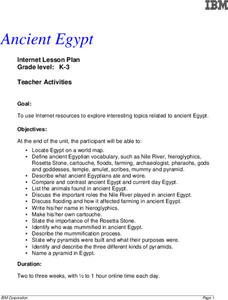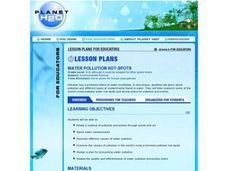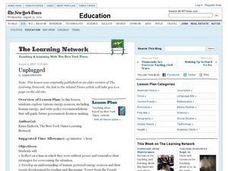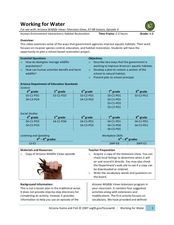Curated OER
Data Collection
Learners investigate qualitative and quantitative data. In this statistics lesson, students gather data on heights and weights of people and graph the distribution. Learners discuss the differences between qualitative and quantitative data.
Curated OER
Brillant, Beautiful Bats!
Students use the internet to gather information on bats. They write their own bat poem and describe the differences between the parts of a bat's body. They identify how bats are important to humans and how they control the insect...
Curated OER
Ancient Egypt
Students use the internet to research topics on Ancient Egypt. They practice using new vocabulary and identify the types of food they ate and clothing they wore. They explain the role of the Nile as well.
Curated OER
Development, Trade, Aid
Twelfth graders study the term development. In this Economics lesson, 12th graders explore the role of trade in stimulating development, with particular focus on the role played by the British Government. Students decide how aid...
Curated OER
Fabric Construction Chart
Students in sewing class review the various types of natural and synthetic fabrics. They take notes about fabric construction and match woven, knit, and non-woven fabric samples to fabric construction charts. They make specific...
Curated OER
Fibers and Fabric
Students are introduced to a variety of different fibers. After acting out a short story, they discover how yarn and basic weaves are made. To end the lesson, they practice making their own weave pattern using paper strips and then yarn.
Curated OER
The Unseen Army: Conscientious Objectors During World War II
Learners study World War II and why it was called "the Good War". In this World War II activity learners identify the different kinds of conscientious objectors.
Curated OER
Classifying Monocot And Dicot Plants
Sixth graders identify the parts of a flower, and tell the difference between monocots and dicots. They group plant by leaf types and characteristics placing the information in table form on the computer.
Curated OER
Deciphering Community
Young scholars explore the concept of a community. They identify and group various kinds of communities. Students create a concept map exemplifying their membership in different communities. They write a narrative describing their...
Curated OER
Water Pollution Hot-Spots
Students complete internet research in small groups to identify types of water pollution, spotlight water pollution hot-spots, and design a plan for water prevention.
Curated OER
Rock Hounds at Heart
Second graders read "Sylvester and the Magic Pebble" by iam Steig and practice describing rocks using different physical properties. They make observations and develop and describe categories such as texture, color, density, hardness, etc.
Curated OER
Community and Me
Students continue to examine the concept of communities. In groups, they identify and create a list of their needs and wants and create artwork showing their community working properly. They describe the differences in communities...
Curated OER
Developing Soundproofing Materials
Eighth graders investigate the acoustic properties of materials in order to develop soundproofing products. In this soundproofing lesson students research different resources, design and perform experiments and fabricate, test and...
Curated OER
Unplugged
Students read the article "Power From the People Breaks the Hold of Batteries and Plugs." Students work in groups to examine various sources of power. Students debate the advantages and disadvantages of each power source. They assume the...
Curated OER
How Do You Get to the Hill ?
Young scholars examine how people end up working in any capacity on Parliament Hill. The day to day focus is on the MPs, but students see that the Hill is essentially a small city that requires a small army to keep operating.
Curated OER
Italian-American Legacy
Students study the role of the Italian government in the migration, also their role in farm life and poverty. They discuss how the Italians supported their families and why they exited to other countries. They discuss how to begin a...
IBM
The Human Body
Every moment, the systems in your body are working together to keep you breathing, standing, and thinking. Elementary schoolers explore the human body and its systems with an impressive, 15-page lesson plan that should leave your...
Curated OER
Language Arts: Two Specific Documents
Students are able to read and analyze the essential parts of two specific types of documents, the informed consent document and the position paper, used by scientists to communicate information about their research to two different kinds...
Curated OER
Economies
Learners discover different economic systems. In this global economy lesson, students research the levels of economic activity, types of economies, maquiladoras and the differences between a free market economy and other systems. This...
Curated OER
Ground Beef Experiment
Students identify what ground beef is and the difference in fat, flavor and moistness between the three types - regular, lean, and extra lean. Then, they conduct an experiment to compare the effect of pan frying
between three different...
Curated OER
Working for Water
Students examine the ways that government works to help improve aquatic habitats. In this water habitats lesson students view a video and plan a school restoration project.
Curated OER
Violence on TV and Our Response
Students examine violence on television. In this media awareness lesson, students discuss the types of fictional and realistic violence shown on American television. Students participate in a Congressional simulation activity on the...
Curated OER
Shopping for Souvenirs In the Middle East
Students participate in a role play in which they are shopping for souvenirs in the Middle East. Using maps, they locate the Middle East and identify each country within the region. They create a key map for the types of souvenirs that...
Curated OER
Hey, Mom! What's for Breakfast?
Students examine how he world eats breakfast. In this food choices lesson, students work in groups to list breakfast foods and their ingredients and find goods and consumers on the list. The, students use the Internet to complete a...

























